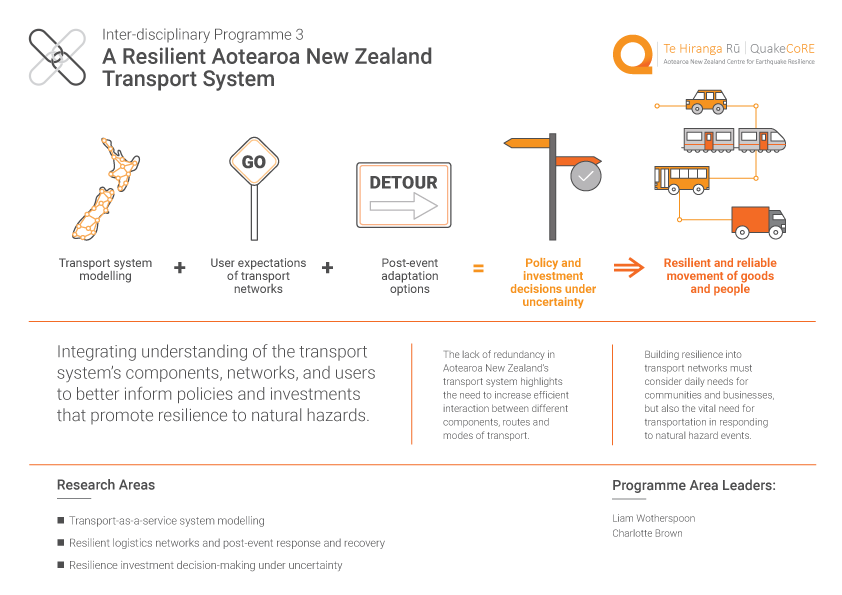IP3 - A Resilient Aotearoa New Zealand Transport System
A resilient transport and logistics system is critical to the ongoing and future viability of businesses and communities across the country, supporting the efficient movement of goods and people. This programme will integrate component- and system-level modelling of networks and their users, consider interaction between different transport and logistics modes, and the social and economic impacts of disruption, to inform policy and investment decisions on the transport and logistics systems of the future.
Research Summary
A systems approach is critical to understand how transport modes interact and to explore options to improve the resilience of transport networks and the energy networks that support their functionality, now and into the future. This theme seeks to integrate our understanding of components1,2, networks3,4 and users5 of the Aotearoa New Zealand (A/NZ) transport system to evaluate pre-event resilience investments and develop post-event adaptations and recovery strategies that can support the range of future growth and consolidation pathways. This requires an understanding of the wider networks and their users, the interfaces between transport modes, the energy sources that support each transport system, and how our resilience to disruption may change as our communities, technology, economy and environment change over time6. Research will seek to answer the following central questions: (i) How can we use a transport-as-as-service modelling paradigm to accurately represent all components of this system? (ii) How can resilient transportation networks and logistics play an enhanced role in post-disaster response and recovery? (iii) How can we approach resilience investment decision-making under uncertainty? Aspects of this research will be framed around multiple earthquake scenarios that result in regional and broader national transport disruption.
Research Outline
A resilient transport system is critical to the ongoing and future viability of businesses and communities across the country, supporting the efficient movement of goods and people. Recent earthquakes, and other natural hazard events, have highlighted the lack of redundancy in the A/NZ transport system, the spatially-variable robustness of different components, and the reliance on functional transport networks to support post-event response and recovery. These events have also demonstrated rapid adaptability by transport system users and providers to ensure the continued movement of people and commodities through alternative transport modes.
This theme has been planned around a multi-disciplinary and collaborative structure, with researchers expected to be involved across the areas described below. This integrated approach will be critical for informing the evolution of the research, with the data and models discussed in this section forming the foundation of the research in the second half of QC2. Within each of the areas below key tasks are summarised, and these will form the structure of a range of post-graduate research projects.
Research will seek to answer the following central questions:
(i) How can we use a transport-as-a-service modelling paradigm to accurately represent all components of this system?
(ii) How can resilient transportation networks and logistics play an enhanced role in post-disaster response and recovery?
(iii) How can we approach resilience investment decision-making under uncertainty?
Our People
Programme Leaders: Liam Wotherspoon, Charlotte Brown
Researchers: Seosamh Costello, Roger Fairclough, Joanna Fountain, Minh Kieu, Cécile L'Hermitte, Tom Logan, Ajay Makhija, Mark Milke, Dario Pietra, Prakash Ranjitkar, Vinod Sadashiva, Nadia Trent, SR Uma, Colin Whittaker, Thomas Wilson, Stuart Woods, Conrad Zorn


